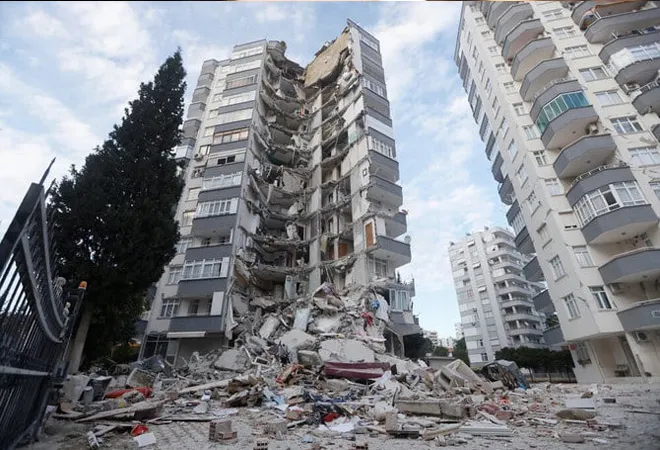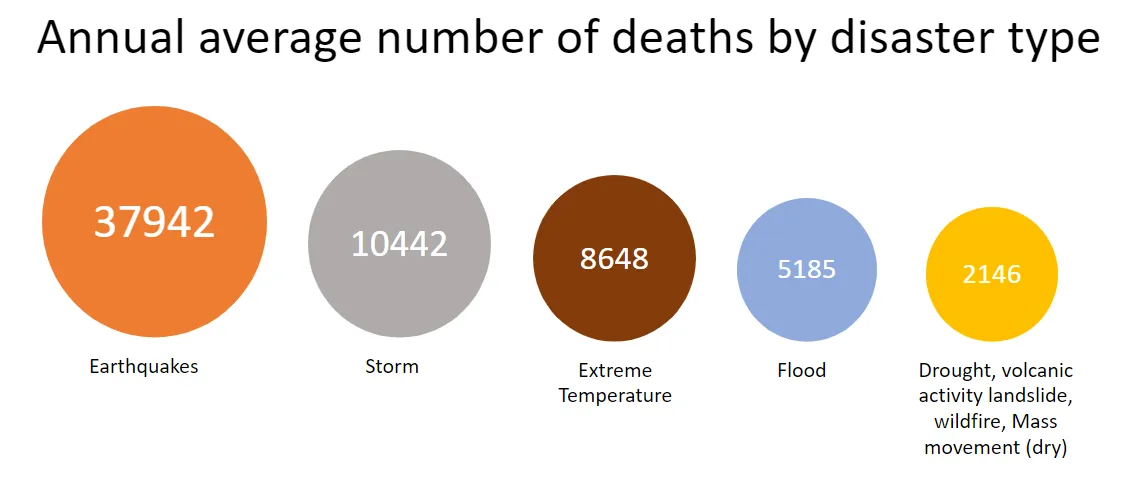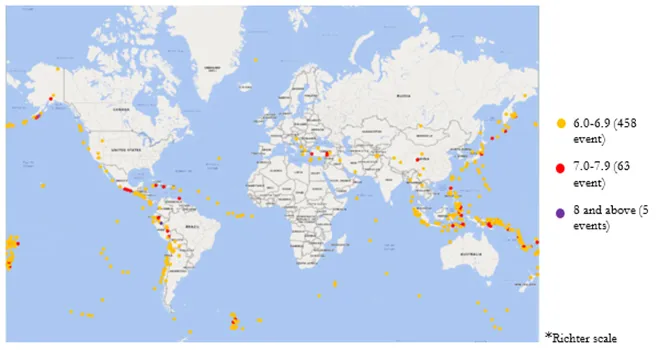-
CENTRES
Progammes & Centres
Location
As the frequency of climate-related disasters rise, there is a greater need for a compounded cooperative approach within the global community

A massive earthquake of 7.8 magnitude devastated Turkiye and Syria in February 2023, claiming more than 46,000 lives. With each passing day, the death toll is on the rise in these countries. The situation is especially concerning in Syria, as there are conflict-ridden areas that are under the control of rebel forces still awaiting help... As per World Health Organization (WHO) chief Tedros Adhanom Ghebreyesus, the WHO hasn’t received the “green light” for entering the rebel-held areas. Thus, the earthquake has compounded the plight of the people in the region who are already suffering the crises of conflict, COVID-19, cholera, and economic decline. The current calamity has put public health in jeopardy, ultimately leading to a rise in the death toll.
Earthquakes are one of the most feared natural phenomena due to their potential to set off a chain of destruction, as seen in Figure 1. The ensuing conditions are generally harsh and pose a threat to a possible disease outbreak which could cause additional losses to the economy and human resources.
Figure 1: Annual Average number of deaths by disaster types (2001-2020)
 Source: Website of the “The United Nations Office for Disaster Risk Reduction”
Source: Website of the “The United Nations Office for Disaster Risk Reduction”
In view of the high fatality rate connected with earthquakes, a multisectoral approach for developing control and preventative measures was required. Following the earthquakes in Mexico in 1985 and Armenia in 1988, the International Search and Rescue Advisory Group (INSARAG) was formed in 1991 by delegates from 15 nations and various organisations. It was established to improve coordination, preparedness, and response at times of calamities. Over three decades of its existence, the INSARAG has been holding regular meetings to incorporate new mechanisms to deal with changing nature of disasters. The United Nations General Assembly (UNGA) Resolution 57/150 endorsed its guidelines as the principal reference for field experts. Similarly, the INSARAG network provided new avenues for state collaboration through initiatives such as the On-Site Operations Coordination Centre (OSOCC).
Over three decades of its existence, the INSARAG has been holding regular meetings to incorporate new mechanisms to deal with changing nature of disasters.
Another example of a multilateral forum seeking to minimise the impact of disasters is the Coalition for Disaster Resilient Infrastructure (CDRI), a coalition of national governments, various UN agencies and Multilateral Development Banks. The initiative, launched by India's Prime Minister Narendra Modi, aims to do research and share knowledge in the fields of risk management, recovery, and finance mechanisms. The CDRI aims to bring changes in the policy frameworks of its member countries to develop disaster-resilient infrastructure which ultimately decreases the economic burden during an event of a disaster. It currently has 31 countries and 8 organisations. This initiative by India further complements the Sendai Framework for Disaster Risk Reduction adopted in 2015 and endorsed by the UNGA. While preparing for prevention, there is a need to focus on building disaster resilience in critical infrastructures like healthcare facilities and schools. In this regard, recognising that the magnitude of the losses incurred during an earthquake, or any natural disaster depends on the damage to these infrastructures. Multiple frameworks, resolutions, and policy decisions have been adopted to develop an integrated strategy for risk reduction. The Sendai Framework and 2030 Agenda, for instance, call for disaster risk reduction plans which have wider scope by including aspects of intersectoral components. Due to the overlapping nature of the frameworks, a collective and coordinated action by multiple stakeholders is necessary.
The occurrence of an earthquake severely impacts public health such as casualties, injuries, and damages to the physical infrastructure of medical facilities. The overwhelming destruction of healthcare infrastructure in the aftermath of an earthquake adds to the misery of the disaster and potentially increases the overall death toll. The following image depicts around 526 earthquakes with magnitude more than 6 that have taken place from 2018 till date. With an average of more than 100 earthquakes per year in the last five years, public health systems across the world need to develop resilience in preparedness and post-disaster response.
Figure 2: Location of Earthquakes with magnitude* 6 and above from 2018 till date (n=526)
 Data Source: United States Geological Survey, 2023
Data Source: United States Geological Survey, 2023
Several emergency activities account for minimising the impact of an earthquake ranging from pre-disaster preparedness and mitigation to post-disaster response and recovery initiatives. The role of the international community, which comprises foreign governments, non-governmental organisations (NGOs), and supranational organisations such as the World Bank, WHO, and others, is crucial in this regard. The role of these players is mainly seen in terms of the prevention and control efforts through education programmes, and designing and building resilient infrastructure in high seismic zones, especially in the least developing economies that are more susceptible to the threat. Additionally, international support can also aid in the identification of areas that need support in medical services and ensure that rescuers and other health professionals reach the disaster struck areas on time. While there have been numerous frameworks, agreements, and resolutions by multilateral fora and UN agencies, the effectiveness of these policies is debateable. Thus, there is a need to formulate policies comprehensively to increase their applicability.
The overwhelming destruction of healthcare infrastructure in the aftermath of an earthquake adds to the misery of the disaster and potentially increases the overall death toll.
The approach to disaster-resilient infrastructure is a complex concept involving cross-disciplinary initiatives. Thus, it is necessary to amalgamate science, policy, and politics to formulate a framework that addresses vulnerability and enhances the adaptive capacity. Since the occurrences of natural disasters have linkages to climate change, it is necessary to undertake effective disaster resilience measures. This is achievable if there is coherence among the various frameworks, agreements, and resolutions developed by the international community. For instance, a collaborative approach using the Sustainable Development Goals, Paris Agreement, and the Sendai Framework could be examined. Within SDGs, Goal 11 speaks about making cities safe, resilient, and inclusive, whereas Goal 13 talks about climate mitigation, and minimising the impact of climate change. The Paris Agreement also explicitly speaks on climate change and disaster risk reduction in Articles 7 and 8., dedicating a paragraph in its preamble on climate change being a potential driver of disaster risk. Thus, it is evident that climate change and disaster risk reduction are interrelated and can be addressed by strengthening coherence.
While it is important to have coalitions and supranational entities to formulate frameworks and governance mechanisms for building better disaster-resilient infrastructures, their effectiveness largely depends on their implementation. Countries need to develop strategies at national as well as subnational levels based on how susceptible an area is to a particular disaster. The development of such policies would help in assigning duties to both governmental and non-governmental actors who play a key role in policy implementation. This would also ensure that the disaster risk governance while being tailored to the need of a geographical location is well-coordinated with the institutional architecture provided by international frameworks. Initiatives like CDRI or even independent donor countries could pitch to help build resilient infrastructure in developing countries that are susceptible to natural calamities. For instance, in CDRI, India provides vast experience in reducing human fatalities during disasters, while Japan brings expertise in technological aid to protect property and infrastructure from extreme weather events. During COP26, for example, the 'Infrastructure for Resilient Island States' initiative intends to provide technical support to Small Island Developing States in order to develop disaster and climate-resilient infrastructure.
Initiatives like CDRI or even independent donor countries could pitch to help build resilient infrastructure in developing countries that are susceptible to natural calamities.
Individual nations need to strengthen their planning to lessen their susceptibility to catastrophes while using internationally agreed frameworks as a reference. However, this can be achieved only when the political commitments are reinforced to promote investment in risk reduction by incorporating disaster resilient as well as sustainable practices. With the increasing frequency of climate-related disasters, the magnitude of the social, economic, and environmental impacts is ever-increasing. Through these crises, the world is reminded that in addition to individual responses, there is a greater need for a compounded cooperative approach between countries, regions, and the world altogether.
The views expressed above belong to the author(s). ORF research and analyses now available on Telegram! Click here to access our curated content — blogs, longforms and interviews.

Kiran Bhatt is a Research Fellow at the Centre for Health Diplomacy, Department of Global Health Governance, Prasanna School of Public Health, Manipal Academy of ...
Read More +
Aniruddha Inamdar is a Research Fellow at the Centre for Health Diplomacy, Department of Global Health Governance, Prasanna School of Public Health, Manipal Academy of ...
Read More +
Miss. Viola Savy Dsouza is a PhD Scholar at Department of Health Policy Prasanna School of Public Health. She holds a Master of Science degree ...
Read More +
Dr. Sanjay M Pattanshetty is Head of theDepartment of Global Health Governance Prasanna School of Public Health Manipal Academy of Higher Education (MAHE) Manipal Karnataka ...
Read More +